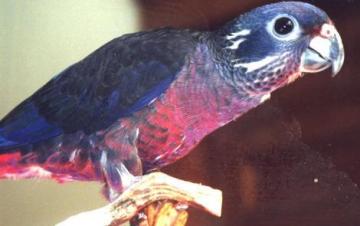Pionus - Dusky
Dusky Parrot Scientific Name: Pionus fuscus
Fri, 1st November, 2024 - 6:27 am GMT
Sponsor Ads:

Alternative Name
Dusky Parrot Scientific Name: Pionus fuscusBasic Info
The Dusky Pionus is native to South America and is fairly common in Venezuela and Brazil. They are seen in a variety of habitats including coastal woodlands, savanna woodlands, and forested areas.
Health
The Dusky Pionus may not do well in an aviary with other birds and may be aggressive. They do not do well in cold temperatures, and if they are to be housed outdoors, temperatures should not fall below 50 degrees Fahrenheit (10 degrees Celsius). The Dusky Pionus enjoys showers and should be misted often. Breeding The Dusky Pionus breeds well in captivity, though because so few wild caught individuals were brought into breeding programs supply is still not meeting demand. In captivity the breeding season usually begins in April. The female will lay a clutch of 3 to 4 eggs, which take 26 days to incubate. Babies will fledge by approximately 70 days and are fully independent in 3 months. Some pairs will have two clutches a year. In the wild the Dusky Pionus breeds between February and May. They tend to nest in dead tress.Habitat
Coastal woodlands, savanna woodlands, and forested areasBehavior
The Dusky Pionus is the rarest of the five Pionus species commonly kept in captivity, though they are increasingly popular. The Dusky Pionus may well be the noisiest of all the different Pionus species, though individuals may vary greatly. In the wild they are often seen in small groups or pairs.They are not heavy chewers, but should be provided toys, so they do not to become bored. Initially they may be shy, but with regular handling they will become quite tame. After taming they are known to be intelligent and quite curious. Males may be more aggressive than females and this should be considered before purchase. xOrigin
South AmericaHistory
The Dusky Pionus is native to South America and is fairly common in Venezuela and Brazil. They are seen in a variety of habitats including coastal woodlands, savanna woodlands, and forested areas.Common Foods
Their diet in the wild has not yet been documented, but in captivity they do well with a varied diet. Fruits and vegetables are a must as well as flower buds, and a healthy varied seed mix and commercial pellets.Sponsor Ads:
"Ground on which we can only be saved from destruction by fighting without delay, is desperate ground." -- Sun Tzu, The Art of War
Pionus - Dusky
Coded by: BGID® | ALL RIGHTS RESERVED Copyright © 2000-2024
Disclaimer | Privacy | Report Errors / Contact | Credits








 President of the United States of America - Real Estate mogul, Pageant owner and now one of the most controversial men in political history.
President of the United States of America - Real Estate mogul, Pageant owner and now one of the most controversial men in political history.  Politician, US Vice President and President of the USA - Joseph Robinette Biden Jr.
Politician, US Vice President and President of the USA - Joseph Robinette Biden Jr.  versus
versus  Russia: 'The Evil Empire'? Are they all that bad or is it just the USA trying to portray Russia as bad because they are a world power with land bigger and a society very different from the USA ideal?
Russia: 'The Evil Empire'? Are they all that bad or is it just the USA trying to portray Russia as bad because they are a world power with land bigger and a society very different from the USA ideal?  Global warming has been in and out as the "latest" hot topic for many years. It is, according to modern scientists, the result of man-made industrial pollutants, clearing forested areas, agriculture, etc. But now they are thinking it started way before the Industrial Revolution...
Global warming has been in and out as the "latest" hot topic for many years. It is, according to modern scientists, the result of man-made industrial pollutants, clearing forested areas, agriculture, etc. But now they are thinking it started way before the Industrial Revolution... 
 Corona virus
Corona virus 
 Users with wide screen monitors can benefit from more content on every page.
Users with wide screen monitors can benefit from more content on every page.